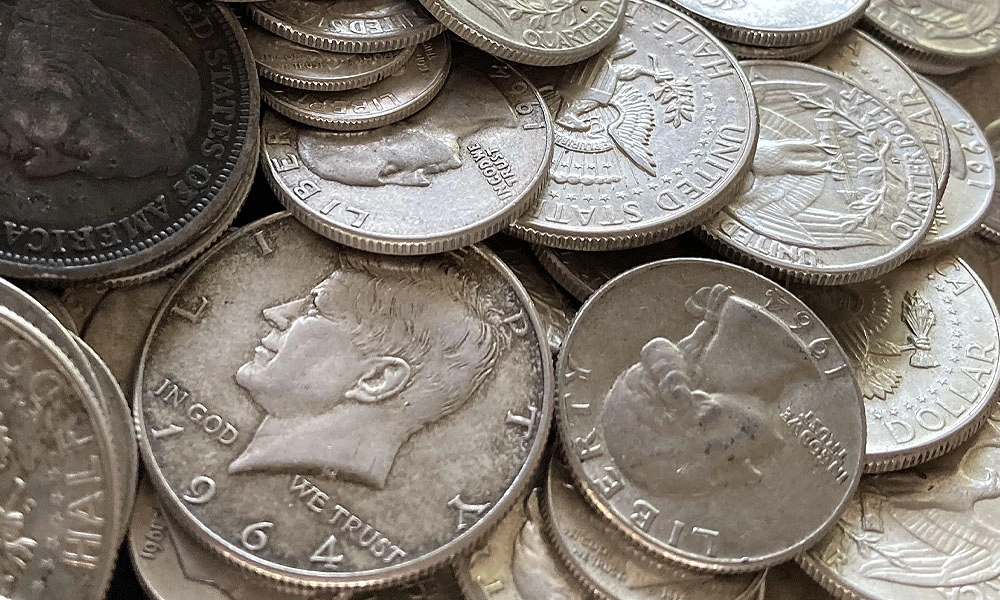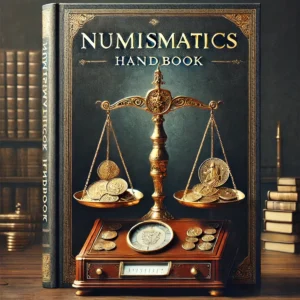What Is Junk Silver and Why Is It Valuable?
Junk silver may sound like scrap, but it refers to pre-1965 U.S. coins made with 90% silver. These everyday dimes, quarters, and half dollars hold real bullion value—making them a practical, recognizable, and cost-effective way to invest in silver.

📘 Download the full guide: Numismatics Handbook — A +135-page resource on US coin collecting.
1) What Is Junk Silver?
When you hear the term “junk silver,” you might picture battered coins that are barely worth anything. However, “junk” in this context does not mean worthless. Instead, it refers to U.S. coins minted before 1965 that contain 90% silver. These coins—such as pre-1965 dimes, quarters, half dollars, and some dollar coins—no longer hold extra numismatic (collector) value due to common mintages or less-than-pristine condition. Their true worth lies in their silver content rather than any rarity factor.

- Historical Background: In 1965, the U.S. government removed silver from most circulating coins. Anything minted before that year typically contained a significant silver component.
- Why “Junk”: The label distinguishes these coins from collectible or graded coins with premiums. Junk silver coins are usually sold for bullion value based on their silver content.
- Simple to Recognize: If a dime, quarter, or half dollar is dated 1964 or earlier, it likely contains 90% silver. Some 40% silver coins exist (like certain Kennedy half dollars from 1965 to 1970), but they are categorized separately.
2) The Appeal: Why Junk Silver Still Matters
- Fractional Ownership: Unlike large silver bars, junk silver coins can be used in small transactions. In a scenario where you might need to barter or make small-scale trades, having coins in lower denominations can be advantageous.
- Historical Significance: Holding coins that circulated decades ago fosters a tangible link to U.S. monetary history. This heritage adds to their appeal for collectors and investors.
- Trusted Authenticity: It is difficult to counterfeit U.S. circulated coins en masse. The wear and tear, combined with official mint markings, make it fairly straightforward to verify authenticity.
- Diversification: Junk silver can be part of a broader stacking strategy, complementing bullion bars, rounds, and modern coins. Its fractional nature offers flexibility when you wish to sell or trade smaller amounts.
3) Best Junk Silver Coins to Buy
- 1964 Washington Quarters
- Each quarter contains 0.1808 troy ounces of silver.
- Widely recognized, making them easy to buy and sell.
- 1964 Kennedy Half Dollars
- Contains 0.3617 troy ounces of silver per coin at 90% purity.
- Slightly more silver than a quarter or dime, so you can accumulate ounces a bit faster.
- Pre-1965 Roosevelt Dimes
- Each dime holds about 0.0723 troy ounces of silver.
- Ideal for ultra-fractional transactions and stacking strategies.
- Walking Liberty and Franklin Half Dollars
- Both feature iconic designs and are 90% silver.
- Some carry mild collector interest, though most are sought for metal value.

GoldSilverStacks Note: Certain Kennedy half dollars minted between 1965 and 1970 contain 40% silver. These are not typically called “junk silver”.
4) Is Junk Silver Worth Investing In?
- Spot Price Correlation: Junk silver’s value fluctuates with the silver spot price. In a bull market, these coins often see robust demand because they offer small denominations with real silver content.
- Premium Considerations: Premiums on junk silver vary. In periods of high demand, prices above spot can climb significantly. Conversely, in quieter markets, premiums may be minimal, making junk silver a cost-effective way to accumulate metal.
- Liquidity: There is a steady market for junk silver among both preppers (who value its barter potential) and conventional stackers looking for fractional silver. Selling is usually straightforward if you stick to commonly recognized coins.
- Long-Term Hedge: If you believe silver prices will trend upward, junk silver can serve as an affordable entry point. Its historical credibility provides extra reassurance compared to lesser-known bullion products.
5) Practical Tips for Buying and Storing Junk Silver
- Buy From Reputable Sources
- Coin shops, online bullion dealers, and peer-to-peer markets can offer junk silver. Make sure the seller is trustworthy to avoid counterfeits or misrepresented coins.
- Check Premiums
- Look at the silver spot price and compare how much over spot you are paying. If premiums spike, consider waiting for more favorable market conditions.
- Sort and Organize
- If you buy in bulk, separate coins by type (quarters, dimes, half dollars) to easily track weight and value.
- Secure Storage
- While junk silver coins may be lower-profile than bars or high-premium coins, security is still essential. Use a safe or bank deposit box if necessary, especially if you accumulate large quantities.
Conclusion
Junk silver is far from junk. These pre-1965 U.S. coins contain 90% silver, blending historical charm with tangible bullion value. For stackers seeking fractional pieces that are widely recognized, this category of coins offers a practical and often cost-effective path to build silver holdings. When markets fluctuate and silver spot prices rise, junk silver can become even more coveted for its affordability and easy divisibility.
- What Is Junk Silver? Pre-1965 U.S. coins minted with 90% silver content.
- Best Junk Silver Coins to Buy? Quarters, dimes, and half dollars from 1964 and earlier, plus some alternatives like 40% silver half dollars.
- Is Junk Silver Worth Investing In? Yes, especially if you value fractional options, historical significance, and potential growth aligned with silver’s price.
If you are curious about smaller-denomination precious metals with real value, junk silver might just be the hidden treasure in your pocket change—well worth adding to your stacking strategy.
FAQs: What Is Junk Silver & How to Invest in It
1. What is junk silver and why is it called that?
Junk silver refers to U.S. coins minted before 1965 that contain 90% silver, like dimes, quarters, and half dollars. The term “junk” simply means they have little or no numismatic (collector) value—their worth comes from silver content, not rarity.
2. Are junk silver coins worth investing in for 2025?
Yes. Junk silver is a practical way to invest in fractional silver. It’s affordable, easy to recognize, and highly liquid. Many stackers use it to hedge against inflation or to prepare for potential barter scenarios.
3. Which junk silver coins are the best to buy?
The most popular junk silver coins are pre-1965 Roosevelt dimes, Washington quarters, and 1964 Kennedy half dollars. These are widely recognized, easy to count by face value, and typically carry low premiums over spot.
4. How much silver is in a junk silver coin?
A pre-1965 dime contains 0.0723 troy ounces of silver, a quarter holds 0.1808 oz, and a half dollar has 0.3617 oz. This makes it easy to calculate your silver holdings by face value—$1 in 90% silver coins equals roughly 0.715 troy ounces.
5. Is junk silver better than silver rounds or bars?
Junk silver is often better for fractional trading and barter, while rounds and bars are ideal for stacking large amounts. Many investors diversify by holding both, depending on their goals and budget.
6. Where can I buy junk silver safely?
You can buy junk silver from local coin shops, reputable online bullion dealers, and coin shows. Always check dealer reviews and compare premiums over spot price before purchasing.
